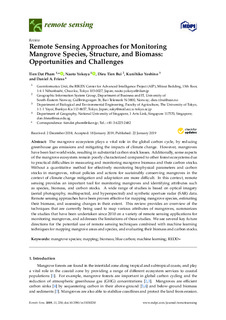| dc.contributor.author | Pham, Tien Dat | |
| dc.contributor.author | Yokoya, Naoto | |
| dc.contributor.author | Tien Bui, Dieu | |
| dc.contributor.author | Yoshino, Kunihiko | |
| dc.contributor.author | Friess, Daniel A. | |
| dc.date.accessioned | 2019-11-06T08:50:21Z | |
| dc.date.available | 2019-11-06T08:50:21Z | |
| dc.date.created | 2019-01-20T23:21:40Z | |
| dc.date.issued | 2019 | |
| dc.identifier.citation | Remote Sensing. 2019, 11 (3), 1-24. | nb_NO |
| dc.identifier.issn | 2072-4292 | |
| dc.identifier.uri | http://hdl.handle.net/11250/2626794 | |
| dc.description | Licensee MDPI, Basel, Switzerland. This article is an open access article distributed under the terms and conditions of the Creative Commons Attribution (CC BY) license | nb_NO |
| dc.description.abstract | The mangrove ecosystem plays a vital role in the global carbon cycle, by reducing greenhouse gas emissions and mitigating the impacts of climate change. However, mangroves have been lost worldwide, resulting in substantial carbon stock losses. Additionally, some aspects of the mangrove ecosystem remain poorly characterized compared to other forest ecosystems due to practical difficulties in measuring and monitoring mangrove biomass and their carbon stocks. Without a quantitative method for effectively monitoring biophysical parameters and carbon stocks in mangroves, robust policies and actions for sustainably conserving mangroves in the context of climate change mitigation and adaptation are more difficult. In this context, remote sensing provides an important tool for monitoring mangroves and identifying attributes such as species, biomass, and carbon stocks. A wide range of studies is based on optical imagery (aerial photography, multispectral, and hyperspectral) and synthetic aperture radar (SAR) data. Remote sensing approaches have been proven effective for mapping mangrove species, estimating their biomass, and assessing changes in their extent. This review provides an overview of the techniques that are currently being used to map various attributes of mangroves, summarizes the studies that have been undertaken since 2010 on a variety of remote sensing applications for monitoring mangroves, and addresses the limitations of these studies. We see several key future directions for the potential use of remote sensing techniques combined with machine learning techniques for mapping mangrove areas and species, and evaluating their biomass and carbon stocks. | nb_NO |
| dc.language.iso | eng | nb_NO |
| dc.rights | Navngivelse 4.0 Internasjonal | * |
| dc.rights.uri | http://creativecommons.org/licenses/by/4.0/deed.no | * |
| dc.title | Remote sensing approaches for monitoring mangrove species, structure and biomass: opportunities and challenges | nb_NO |
| dc.type | Journal article | nb_NO |
| dc.type | Peer reviewed | nb_NO |
| dc.description.version | publishedVersion | nb_NO |
| dc.rights.holder | © 2019 by the authors. | nb_NO |
| dc.source.pagenumber | 1-24 | nb_NO |
| dc.source.volume | 11 | nb_NO |
| dc.source.journal | Remote Sensing | nb_NO |
| dc.source.issue | 3 | nb_NO |
| dc.identifier.doi | 10.3390/rs11030230 | |
| dc.identifier.cristin | 1661794 | |
| cristin.unitcode | 222,57,1,0 | |
| cristin.unitname | Institutt for økonomi og IT | |
| cristin.ispublished | true | |
| cristin.fulltext | original | |
| cristin.qualitycode | 1 | |

